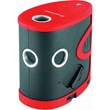
Buyers Guide to Rotary Laser Levels
Self-leveling rotary lasers levels make construction projects a lot easier. In a matter of seconds, they produce perfectly level horizontal or vertical lines without the hassle of using chalks or strings. Rotary laser levels make measurements faster, easier, and far more accurate.
When purchasing a self-leveling rotary laser level, you need to consider the following factors to make sure that you get exactly what you need. In this guide, we’re going to discuss the questions you need to answer before making your purchase or rental of a rotary laser level.
1. How will the self-leveling rotary laser level be used?
How you plan on using the laser level will determine the features that you need. Will you use it to create a straight vertical line to install a floor-to-ceiling window? Then you’d need a laser level that can be used vertically. If you’re a professional contractor working in a large area, you’d need a laser level with a large operating range and maybe even a remote control for easier operation.

Main Features to consider when purchasing a rotary laser level:
- Range – The larger your working area is, the larger the working range you should look for.
- Accuracy - Most rotary laser levels have an accuracy ranging from 1/8" to 1/16" and become less accurate the farther away in range. Be sure to know the accuracy you need for the job!
- Rechargeable or Dry cell Batteries – Laser levels are usually powered by alkaline or Ni-MH batteries. It comes down to personal preference to in which type to use, however, we see that many people purchase the rechargeable batteries and purchase the dry cell packs as a backup just in case. In addition, it’s always better to have long-lasting battery to minimize the cost of replacement or downtimes due to charging.
- Mounting options – Rotary laser levels are typically mounted on a tripod but can also be mounted on a wall using a magnet or a pole using a mounting bracket. You need to purchase a unit with the mounting option appropriate for how you will use the laser level.
- IP Rating - Working outdoors also exposes your laser level to harsh weather elements, dirt, drops, and more hazards. If you’ll be working often in a tough job site, you should get a waterproof and dustproof laser level (IP54 and up) with a rugged housing that protects it from high drops.
- Automatic out-of-level alerts – Most self-leveling rotary lasers automatically alert you if it goes out of level. This alert is usually a blinking light. Some models stop working altogether once the instrument stays out of level for 5 minutes or so. This feature comes in handy when working on large construction sites as you are typically working far away from the laser.
**Note: If you need a rotary laser level where you can enter a grade, you’ll need a grade laser.
2. Where will you be using the rotary laser?
Will you be using the laser level indoors, outdoors, or a combination of both? Red lasers can be seen in dim lights, making them better for indoor applications. For indoor applications with bright lighting, it’s best to go with a green laser since they are 4 times easier to see than the red beam. If you want to use a rotary laser level outdoors, you must use a laser detector to detect the laser within a distance. This is because the human eye can not see a laser outside in bright daylight conditions.

3. What budget are you working with?
More expensive rotary lasers have advanced features that can make your work easier. For example, some models include a wireless remote control which can prove useful if you’re working in a large area.
Other models also have automatic horizontal or vertical alignment feature which greatly reduces error due to weather, improper calibration, and other factors. Another feature you might want to have is a manual slope operation where you can manually tilt the laser to match a required slope.

If you’re going to work with corners, it’s best to get a rotary laser level capable of a 90-degree layout and split beam.
Ultimately, choosing a self-leveling rotary laser level is a matter of knowing your budget and deciding which features you can and cannot live without depending on how you use it. If you need help in choosing the best self-leveling rotary laser for your needs, get in touch with us today to talk to one of our experts.
Click here to browse our largest selection of rotary laser levels.


































